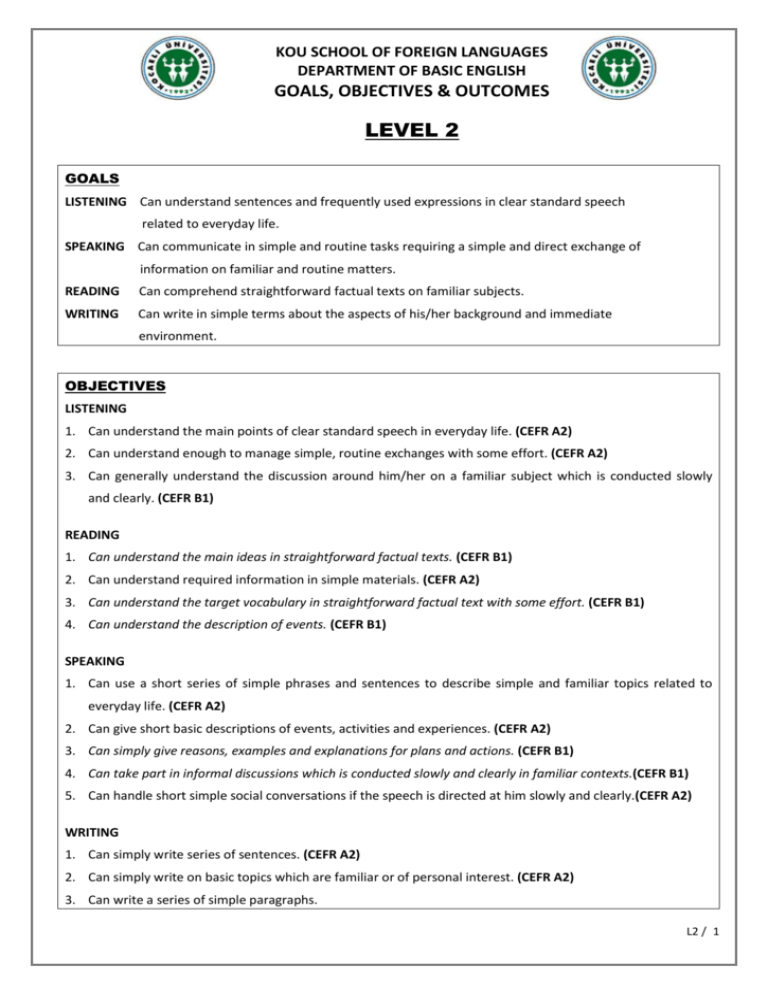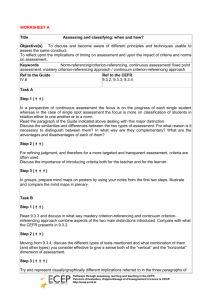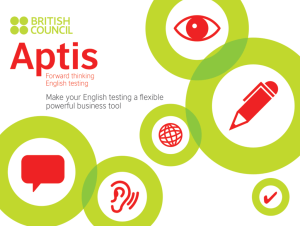KOU SCHOOL OF FOREIGN LANGUAGES
advertisement

KOU SCHOOL OF FOREIGN LANGUAGES DEPARTMENT OF BASIC ENGLISH GOALS, OBJECTIVES & OUTCOMES LEVEL 2 GOALS LISTENING Can understand sentences and frequently used expressions in clear standard speech related to everyday life. SPEAKING Can communicate in simple and routine tasks requiring a simple and direct exchange of information on familiar and routine matters. READING Can comprehend straightforward factual texts on familiar subjects. WRITING Can write in simple terms about the aspects of his/her background and immediate environment. OBJECTIVES LISTENING 1. Can understand the main points of clear standard speech in everyday life. (CEFR A2) 2. Can understand enough to manage simple, routine exchanges with some effort. (CEFR A2) 3. Can generally understand the discussion around him/her on a familiar subject which is conducted slowly and clearly. (CEFR B1) READING 1. Can understand the main ideas in straightforward factual texts. (CEFR B1) 2. Can understand required information in simple materials. (CEFR A2) 3. Can understand the target vocabulary in straightforward factual text with some effort. (CEFR B1) 4. Can understand the description of events. (CEFR B1) SPEAKING 1. Can use a short series of simple phrases and sentences to describe simple and familiar topics related to everyday life. (CEFR A2) 2. Can give short basic descriptions of events, activities and experiences. (CEFR A2) 3. Can simply give reasons, examples and explanations for plans and actions. (CEFR B1) 4. Can take part in informal discussions which is conducted slowly and clearly in familiar contexts.(CEFR B1) 5. Can handle short simple social conversations if the speech is directed at him slowly and clearly.(CEFR A2) WRITING 1. Can simply write series of sentences. (CEFR A2) 2. Can simply write on basic topics which are familiar or of personal interest. (CEFR A2) 3. Can write a series of simple paragraphs. L2 / 1 KOU SCHOOL OF FOREIGN LANGUAGES DEPARTMENT OF BASIC ENGLISH GOALS, OBJECTIVES & OUTCOMES OUTCOMES LISTENING 1. Can get the basic facts in simple texts. 2. Can get the main ideas in conversations and speeches. 3. Can catch the main points in speeches on familiar topics like basic personal and family information, leisure, school, work, etc. 4. Can follow classroom instructions 5. Can handle simple telephone conversations. 6. Can catch specific information in speeches. 7. Can simply infer the context of the text. 8. Can get the topic of the discussion. 9. Can get the main idea of a discussion. 10. Can generally follow opinions in a discussion. 11. Can catch the flow of straightforward input. SPEAKING 12. Can describe habits and routines. 13. Can simply describe everyday aspects of his/her environment e.g. people, places, a job or an object. 14. Can talk about personal likes and dislikes. 15. Can talk about prohibitions, obligations and necessities. 16. Can tell a story in a simple list of points. 17. Can use basic linkers to connect ideas. 18. Can shortly talk about current events, activities and personal experiences. 19. Can shortly talk about past events, activities or personal experiences. 20. Can give a short, rehearsed basic presentation on a familiar subject. 21. Can talk about future plans and intentions. 22. Can answer straightforward follow up questions if he/she can ask for repetition and if some help with the formulation of his/her reply is possible. 23. Can express or seek personal views or opinions in a simple way. 24. Can give immediate answers and reactions with some pauses and misunderstandings. 25. Can ask and answer questions on various topics. 26. Can keep the conversation going his/her accord by asking and answering questions. 27. Can simply express and respond to feelings such as surprise, interest and happiness. 28. Can take part in a conversation by repeating, interrupting or hesitating when needed. L2 / 2 KOU SCHOOL OF FOREIGN LANGUAGES DEPARTMENT OF BASIC ENGLISH GOALS, OBJECTIVES & OUTCOMES 29. Can simply initiate and maintain different conversations with different purposes like advice, permission, suggestions, complaint, apology, invitation etc. 30. Can deal with common aspects of everyday life. 31. Can make himself/herself understood in an interview and communicate ideas and information on familiar topics, provided he/she can ask for clarification occasionally, and is given some help to express what he/she wants to. READING 32. Can predict the content of texts using the headings or pictures. 33. Can catch the main idea in authentic, adapted or familiar texts. 34. Can find specific information in authentic, adapted or familiar texts by scanning. 35. Can follow simple instructions in written materials. 36. Can guess the meanings of unknown words in straightforward factual text. 37. Can use a monolingual or a bilingual dictionary at the appropriate level. 38. Can make basic inferences. 39. Can catch the main events in a story. 40. Can follow the order of the events. 41. Can follow the ideas in other patterns of texts such as opinion, cause and effect, contrast, etc. 42. Can work out the meaning of basic abbreviations and symbols like “e.g., etc.” WRITING 43. Can simply take down notes provided the speech is clear. 44. Can write simple phrases and sentences to meet his/her immediate needs.(e-mail, notes, text msgs, etc) 45. Can write a series of simple phrases and sentences about people, places, a job or study experience, etc. 46. Can write very short, basic descriptions of events, past activities and personal experiences or interest. 47. Can support his/her ideas in writing. 48. Can use basic linkers to connect ideas or sentences. 49. Can apply the basic rules of punctuation, spelling, capitalization and reference. 50. Can write notes for in-class presentation, an outline and a simple report in simple short paragraphs. 51. Can pick out and reproduce key words and phrases or short sentences from a short text within the learner’s limited competence and experience. L2 / 3











